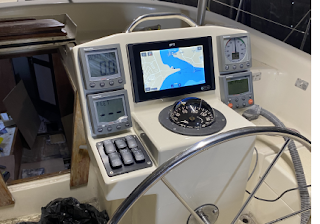Last spring it all started with a little drip...
 |
| Fig. 1 |
In the spring of 2019 I was checking on the boat and found this little surprise waiting for me. It was wet, but not water wet, It was hydraulic fluid wet! and on a Morgan Out Island Hydraulic fluid can only come from one place, the steering system! When we got the boat in 2015 the steering system had not had any fluid in it for a number of years. We filled the system in 2016 to get her home and the system held fluid (and seemed to work well). After our initial fixes to get the boat up and running to bring her home to Whitby Ontario we discovered over the winter that the helm pump needed new seals, so that was rebuilt.
Over the years We suspect that the original fabrication of the stern tube left a little to be desired in terms of quality and completeness. On the inside of the keel there was a section of "deadwood" that was made up of a small plywood bulkhead, fiberglass stern tube, foam and some roving to seal it all up. in Fig 2. you can see that the fiberglass rovings stop short of the actual bulkhead leaving the foam exposed, and the cracks in the foam. Over the years the foam had cracked, filled with anything that had leaked in ( including water) and freeze thaw cycles just made the whole thing worse.
 |
| Fig. 2 |
So the decision was taken to try to fix this problem properly and to try to use materials that will not rot. I decided that the old tube and the material around it needed to be removed in order to do the repair properly. At the very least I needed to get down past all the contaminated material so that repairs would actually stick. Step 1 was to remove all the old material. This proved harder than expected as the foam that was originally used must have been 25lb or denser!!
 |
| Fig. 3 |
April, May and June weekends were spent chipping away at the old material. It was difficult to access this part of the keet as the bottom is nearly 2 feet below the cabin sole and the space is only 10 inches wide, so weekends were spent chipping way in 3 hrs sessions as this was all my arms could deal with. (fig.3)
 |
| Fig. 4 |
Finally with everything removed I fabricated a new bulkhead out of 5 alternating layers of biaxial 1708 and 18oz roving ( to bulk up the laminate) saturated with epoxy. Once cured it was cut to fit based on a template I made before all the weeks of demolition. Fig .4 shows the new bulkhead epoxied in place with fillets, a hole cut for the fiberglass stern tube and 3/8" spacers all around to keep the prop shaft centered. The stern tube is a length of fiberglass schedule 80 pipe (filament wound) that I found online. I could online buy it in 4ft lengths so I have an extra 2ft length lying around if anyone else has a stern tube to rebuild!!!
 |
| Fig. 5 |
With the tube epoxied in place I glassed it to the hull, bulkhead and end of the bulkhead and the end of the keel. 1708 is wonderful in that it will conform to multiple compound curves at the same time! 4 layers of this in epoxy will hopefully ensure that there is no more fixes for this! (fig. 5)
 |
| Fig. 6 |
On the outside where the tube passes through the hull I choose to leave it stick out 3/4 of an inch. This combined with a big bevel dished into the keel hopefully ensured that there was lots of material to epoxy to. The outside was adhered to the hull with a mix of epoxy, cabosil and as much milled fibres ( little strands of glass approx. 3/4" long) as the mix would hold. This was pressed into the joint and worked so that there was as much glass in the joint as it would take. and then smoothed to form a nice finished surface (fig. 6)
 |
| Fig. 7 |
Back to the inside. the void was filled with as much 2 part 20lb closed cell pourable foam as needed to fill the area, I choose to finish the deadwood differently than factory as the original configuration created a small dammed area (not sure why) Now the contour will help any water that gets in there to be shed down to the bilge. the whole thing was covered with another 5 layers of 1708 in epoxy and smoothed and tabbed to the sides of the keel. Once it was cured and faired it received 3 coats of Interlux bilgekote
On the outside the opening for the cutless bearing was faired and will in the 2020 spring receive 3 coats of Interlux interprotect and a couple of coats of bottom paint.
 |
| Finished!!! |
All of this made a mess of the aft cabin and lead me to discover other age related issues but that's a story for another post!!!










Comments
Post a Comment